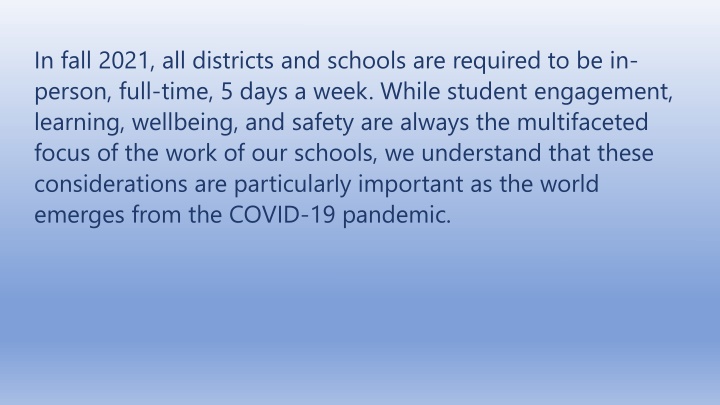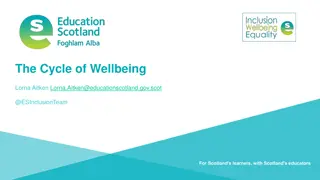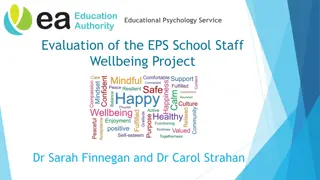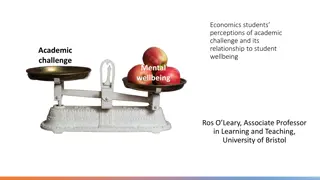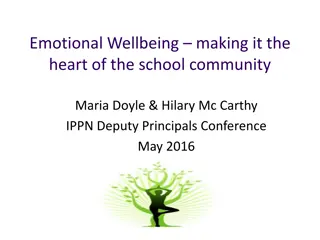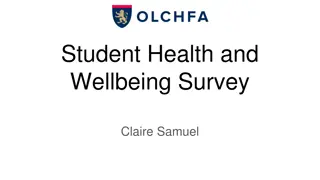Resources for Promoting Student Engagement and Wellbeing in Fall 2021
In Fall 2021, schools are mandated to resume in-person, full-time classes. This PowerPoint resource emphasizes student engagement, learning, wellbeing, and safety in the post-COVID-19 era. It provides guidance on fostering belonging, connecting with families, attendance strategies, and supporting students with intensive needs. School leaders can use this template to enhance orientation and training resources effectively.
Download Presentation

Please find below an Image/Link to download the presentation.
The content on the website is provided AS IS for your information and personal use only. It may not be sold, licensed, or shared on other websites without obtaining consent from the author.If you encounter any issues during the download, it is possible that the publisher has removed the file from their server.
You are allowed to download the files provided on this website for personal or commercial use, subject to the condition that they are used lawfully. All files are the property of their respective owners.
The content on the website is provided AS IS for your information and personal use only. It may not be sold, licensed, or shared on other websites without obtaining consent from the author.
E N D
Presentation Transcript
In fall 2021, all districts and schools are required to be in- person, full-time, 5 days a week. While student engagement, learning, wellbeing, and safety are always the multifaceted focus of the work of our schools, we understand that these considerations are particularly important as the world emerges from the COVID-19 pandemic.
This PowerPoint is intended as a resource/template for school/district leaders to use to share key information from the Department resource: Promoting Student Engagement, Learning, Wellbeing and Safety School Year 2021-2022 (Released Summer 2021). Please edit/copy/paste as is helpful to supplement existing school/district orientation and training resources.
Promoting Student Engagement, Learning, Wellbeing and Safety School Year 2021-22
01 Introduction 02 Engaging and Connecting with Students and Families Supporting Students More Intensive Needs 03 Contents 04 Attendance as a Tool for Engagement and Safety Recognizing Abuse and/or Neglect & Fulfilling Mandated Reporter Responsibilities 05 Appendix: Special Considerations for Students Learning Remotely 06 Resources 07
01 Introduction
Priority 1: Foster a Sense of belonging and partnership among students and families. Recognizing Abuse and/or Neglect & Fulfilling Mandated Reporter Responsibilities Engaging Families as Partners Re-envisioning School Culture and the Conditions for Learning Cultivating Positive Behavior Engaging and Connecting with Students and Families Promote Student Engagement, Learning, Wellbeing, and Safety Attendance as a Tool for Engagement and Safety Supporting Students More Intensive Needs 6 Massachusetts Department of Elementary and Secondary Education
Engaging and Connecting with Students and Families 02
Engaging Families as Partners Strategies: Maintain strong, consistent, ongoing, two-way communication with families using culturally and linguistically responsive practices. Gather information and feedback about family strengths and support needs. Set common expectations among staff about roles and responsibilities to support families. Collaborate with community leaders and connectors. Connect families to resources. 8 Massachusetts Department of Elementary and Secondary Education
Engaging Families as Partners. Consider Equity-Related Questions: How and when do families and caregivers have a voice in student and school matters? What happens to the input they provide? How are improvements and changes communicated back to them? Are family communication, support, and care coordination systems designed with the most marginalized families in mind, rather than the mythical typical parent ? Are a family s many strengths being considered using an assets-based approach for engagement? Are regular conversations occurring with all staff responsible for family outreach about the fears and realities that Black, Indigenous, and People of Color (BIPOC) families are experiencing and how these may be affecting learning and the school experience? 9 Massachusetts Department of Elementary and Secondary Education
Re-envisioning School Culture and the Conditions for Learning Strategies: Continue to allocate time for culture and community building. Focus on relationship-building. Make social emotional well-being and collective care a normal and visible part of the school for students, staff, and families. 10 Massachusetts Department of Elementary and Secondary Education
Re-envisioning School Culture and the Conditions for Learning. Consider Equity-Related Questions: What methods are being used to create emotional safety and support for students and families of color? What steps have been taken to get student and family feedback about this question? 11 Massachusetts Department of Elementary and Secondary Education
Cultivating Positive Behavior Strategies: Clearly define what positive behavior looks like and proactively and creatively update the entire school community regarding expectations and student development strategies related to positive behavior. Prioritize teaching and modeling behavioral expectations in the classroom and at home. Take proportionate and contextualized responses to deviations from behavioral expectations. 12 Massachusetts Department of Elementary and Secondary Education
Cultivating Positive Behavior. Consider Equity-Related Questions: Are the school s behavioral expectations aligned with and reflective of the norms and values of all students backgrounds and identities? What steps have been taken to get student and family feedback about this question? Will new behavioral expectations and consequences disproportionately impact specific student groups (e.g., students with disabilities, students who have experienced trauma)? What restorative measures can be taken to support students in the adoption of behaviors required for health and safety reasons? What data or input does the school have about the quality of instruction and level of engagement of students from different backgrounds and identities? To what extent might behaviors be related to instructional choices (e.g., engaging instruction/deeper learning, student voice and choice, culturally responsive pedagogy and materials)? 13 Massachusetts Department of Elementary and Secondary Education
Supporting Students More Intensive Needs 03
Supporting More Intensive Needs Strategies: Ensure that staff and families know what to look for. Use mental health screeners to identify students who need targeted and intensive supports (Tier 2 and 3). Identify and use research-based Tier 2 and Tier 3 supports and services. Anticipate student needs, adjust methods of delivery, and make referrals accordingly. 15 Massachusetts Department of Elementary and Secondary Education
Supporting More Intensive Needs. Consider Equity-Related Questions: What data is collected and analyzed to identify trends in students who are referred to more intensive supports and services? Are data collection tools culturally responsive and/or being used in a culturally responsive way? What additional data might be needed? What systems and practices are in place to determine the efficacy of services, including trends in efficacy by populations of students? 16 Massachusetts Department of Elementary and Secondary Education
Attendance as a Tool for Engagement and Safety 04
Attendance as a Tool for Engagement and Safety (continued) Elements included in attendance policies and protocols: Clearly define terms related to absence. Convey the importance of regular attendance and engagement. Establish when and how attendance is reported and documented, by whom and to whom. Outline the circumstances for when schools will check-in with students and families, how this will take place and be documented, and with whom schools will conduct check-ins during and following absences, including establishing clear expectations about when the school requires direct contact with the student themself. Identify the school personnel responsible for following up with students and families to identify and address factors contributing to chronic absences. 18 Massachusetts Department of Elementary and Secondary Education
Attendance as a Tool for Engagement and Safety (continued) Elements included in attendance policies and protocols: Ensure communication about the student s attendance status among those who are engaged with the student. Consider the method(s) that school personnel will use for such communications. Provide tools to help staff, including support staff, understand their roles and to facilitate tracking, monitoring and following up when students are absent, particularly for chronic absence. Establish clear, predictable consequences for absenteeism that support student reengagement. Identify available supports and services, including and when and how referrals will be made [e.g., to a Family Resource Center (FRC). 19 Massachusetts Department of Elementary and Secondary Education
Attendance as a Tool for Engagement and Safety. Consider Equity-Related Questions: What data is collected and analyzed to identify trends in students who are chronically absent? What systems and practices are in place to determine the efficacy of services, including trends in efficacy by populations of students? 20 Massachusetts Department of Elementary and Secondary Education
Recognizing Abuse and/or Neglect & Fulfilling Mandated Reporter Responsibilities 05
Recognizing Abuse and/or Neglect & Fulfilling Mandated Reporter Responsibilities. Important Considerations Relating to 51As (particularly for issues related to engagement, truancy, and absenteeism): Has the school/district explored and documented all possible opportunities to support and assist the student and their family to overcome barriers to engagement and attendance (e.g., technology access if the student is learning remotely, support, etc.)? What additional supports might be needed and how can students and families get connected to those supports? What alternative learning opportunities might be available to support engagement? Has the school/district reviewed data to identify whether there is an over-reliance on 51A filings as an intervention for specific student groups (e.g., students of color, students with disabilities, etc.)? Reporting to DCF is referred to as filing a 51A, after the section in the law (M.G.L. c. 119, s. 51A) that covers mandated reporting of child abuse and neglect. 22 Massachusetts Department of Elementary and Secondary Education
Recognizing Abuse and/or Neglect & Fulfilling Mandated Reporter Responsibillties (continued) Concerns that may require contacting DCF to report an allegation of abuse or neglect: When there is a legitimate concern about abuse or neglect and students and/or families are non-responsive to ongoing, multiple, and varied efforts to connect and engage. Chronic truancy or absence from school programming where efforts to engage the child and family in supportive services have been unsuccessful. Observation of unexplained or suspicious bruising, welts, cuts, or other injuries on a child. Observation of or reasonable cause to believe the child, adult, or caregiver is providing care while under the influence of drugs or alcohol that could be resulting in abuse or neglect. 23 Massachusetts Department of Elementary and Secondary Education
Recognizing Abuse and/or Neglect & Fulfilling Mandated Reporter Responsibilities(continued). Concerns that may require contacting DCF to report an allegation of abuse or neglect: Observation of or a student discloses abuse or neglect. Any other time there is reasonable cause to believe that a child(ren) is being abused or neglected. (This reasonable cause can be based on expertise as an educator and/or past experiences with this child or family.) 24 Massachusetts Department of Elementary and Secondary Education
How do I make a Report of Suspected Child Abuse and/or Neglect? When you suspect that a child is being abused and/or neglected, you should immediately telephone Child-At-Risk Hotline at 800-792-5200 any other time, including after 5 pm and on weekends and holidays DCF Area Offices between 9 am and 5 pm weekdays 25 Massachusetts Department of Elementary and Secondary Education
Appendix: Special Considerations for Students Learning Remotely 06
Special Considerations for Remote Learning This fall, all schools and districts are required to resume full, in-person learning, but in exceptional cases remote learning may continue to be an option. Remote learning may be appropriate for students with medical conditions who may need educational services in the home or hospital setting (requires Physician s Affirmation), students attending in-district virtual schools, or students attending approved district virtual programs. 27 Massachusetts Department of Elementary and Secondary Education
Learning Time Requirements As set forth in the DESE Guidance on In-Person Learning and Student Learning Time Requirements (April 27, 2021), please recall that, [S]chools and districts are required to include a visual component as part of the daily live check-in that is needed to support students whose families have selected a remote model of instruction for the remainder of the school year. 28 Massachusetts Department of Elementary and Secondary Education
Engaging Families of Students Learning Remotely Special Considerations: Schools should develop a protocol for daily visual check-ins, home visits (when appropriate) and other forms of communication with families whose children are learning remotely. Schools should provide clear information about the types of supports the district will provide even when students are learning remotely, such as special education services, EL services, and mental health supports. Schools should also consider assigning one or more point people at the district who are responsible for regular communication and coordination with families of students learning remotely. Schools should also consider strategies for creating a sense of community and connection among families learning remotely. 29 Massachusetts Department of Elementary and Secondary Education
Re-Envisioning School Culture and Learning Conditions for Students Learning Remotely Special Considerations: Establishing clear schedules and easy access to teacher-facilitated (synchronous), independent learning (asynchronous), and teacher office hour opportunities. Offering activities that build a sense of community and belonging and provide a clear support system Engaging in explicit work with students on the social emotional aspects of remote learning, including social emotional skills they need to manage learning, screen time management, strategies to combat isolation, self-advocacy skills, goal-setting, etc. Employing strategies for orienting families and students on all aspects of remote learning and for checking with families and students on a regular basis to gather input on their experiences (daily student check-in (visual check-in) and check-out (CICO) routines, family feedback meetings, regular survey and/or focus groups). 30 Massachusetts Department of Elementary and Secondary Education
Cultivating Positive Behavior among Students Learning Remotely Special Considerations: Consider how the school can proactively support students and their parents/caregivers to set up positive routines and behaviors while learning at home. Establish, teach, and practice norms for remote learning. Work with support staff and families to proactively identify students who might struggle in a remote environment and co-develop a plan to support them. 31 Massachusetts Department of Elementary and Secondary Education
Supporting the More Intensive Needs of Students Learning Remotely Special Considerations: Ensure regular virtual face time and/or conduct home visits when needed. Consider using a mental health screener. Be sure that families are aware of their rights to mental health and/or special education services. Work collaboratively with the family to identify if services are most effectively done in-person and what options are available. Establish a frequent and routine (daily, weekly) protocol for monitoring the use and effectiveness of services (including monitoring by staff beyond direct service providers). Connect with the student support team and family immediately to problem-solve if school attendance or participation in services lapses. 32 Massachusetts Department of Elementary and Secondary Education
Using Attendance as a Tool for the Engagement and Safety of Students Learning Remotely Special Considerations: Schools and districts should consider the many factors that may contribute to a student s participation and attendance in remote learning. Does the student have access to the necessary technology (e.g., devices, internet access, etc.) to fully participate? Does the student or their family need technical support (e.g., accessing needed apps or software, troubleshooting camera/audio issues, etc.)? Does the student have access to appropriate space for learning (particularly for students in congregate care settings, homeless students in shelters or doubled- up ) and/or supports to help mitigate space limitations (e.g., noise cancelling headphones, etc.)? Are accommodations needed related to a disability? 33 Massachusetts Department of Elementary and Secondary Education
07 Resources
Resources(1): Re-envisioning School Culture and the Conditions for Learning Engaging Families as Partners Safe and Supportive Schools (DESE webpage) Social and Emotional Learning in Massachusetts (DESE webpage) Multi-Tiered System of Support (MTSS) (DESE webpage) Culturally Responsive Teaching and Leading (DESE webpage) Culturally Responsive and Sustaining Schools and Classrooms (DESE webpage) Re-Imagine and Rebuild: Restarting School with Equity at the Center How Schools Can Help Kids Heal After a Year of Crisis and Uncertainty - NPR No More Easy Button: A Suggested Approach to Post-Pandemic Teaching What Does Good Classroom Design Look Like in the Age of Social Distancing? Four Core Priorities for Trauma-Informed Distance Learning Strengthening Partnerships: A Framework for Prenatal Through Young Adulthood Family Engagement Framework (DESE webpage) Massachusetts Family, School, and Community Partnership Fundamentals - Version 2.0 (DESE webpage) Dual Capacity-Building Framework for Family School Partnerships Engaging Families Using the MTSS Model: Love in the Time of COVID Mass General Hospital COVID-19 Mental Health Resources for Families and Children Engaging Families in Social Emotional Learning - Edutopia Learning Heroes MassSupport Remote Learning Practice Profile: Relationship Mapping to Support Positive School Connections 35 Massachusetts Department of Elementary and Secondary Education
Resources(2): Cultivating Positive Behavior Supporting More Intensive Needs DESE-Sponsored Youth Mental Health First Aid Training Mental and Behavioral Health Resources (DESE webpage) Massachusetts CBHI Services Network of Care Massachusetts Handholdma.org Supporting the SEL and Mental Health Needs of Students and Educators in the COVID-19 Era DPH Suicide Prevention Program Behavioral Health Integrated Resources for Children Project (BIRCh) Online Learning Modules Returning to School During and After Crisis: A Guide to Supporting States, Districts, Schools, Educators, and Students through a Multi-Tiered Systems of Support Framework during the 2020-2021 School Year COVID-19 Resources: General Restorative Practices Center on Positive Behavior Interventions & Supports 36 Massachusetts Department of Elementary and Secondary Education
Resources(3): Attendance as a Tool for Engagement and Safety Recognizing Abuse and/or Neglect & Fulfilling Mandated Reporter Responsiblities Student Attendance and Chronic Absenteeism (DESE webpage) Pathways to Engagement: A Toolkit for Covid-19 Recovery Through Attendance DCF's Reporting Abuse and Neglect webpage DCF Mandated Reporter Guide Middlesex County District Attorney s Office - 51A Online Mandated Reporter Training Promising Approaches: Working with Families Child Welfare and Domestic Violence Safe Kids Thrive Joint Advisory Regarding School District Officials' Duty to Report Suspected Child Abuse and Neglect (an update to this advisory is forthcoming) 37 Massachusetts Department of Elementary and Secondary Education
